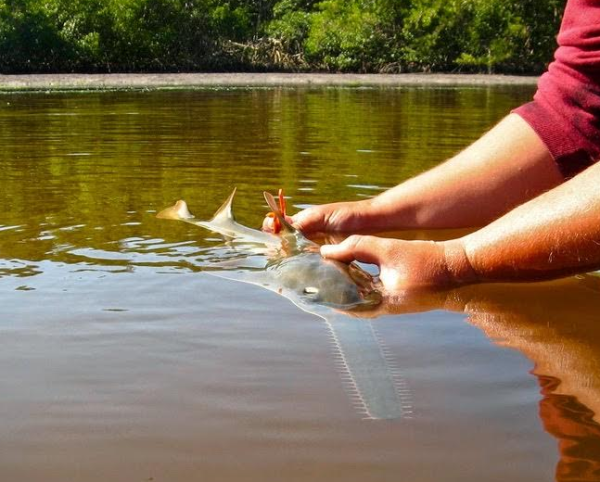 Following a listing as “Endangered” under the Endangered Species Act (ESA) for the U.S. population of smalltooth sawfish (Pristis pectinata) in 2003, NOAA Fisheries designated critical habitat for juveniles in 2009. But what exactly does that mean and what does that do?
Following a listing as “Endangered” under the Endangered Species Act (ESA) for the U.S. population of smalltooth sawfish (Pristis pectinata) in 2003, NOAA Fisheries designated critical habitat for juveniles in 2009. But what exactly does that mean and what does that do?
The primary reason for the decline of the smalltooth sawfish population in the United States was mortality following capture in various commercial and recreational fisheries. The secondary reason for the decline was habitat loss largely associated with coastal development and degradation. Therefore, the preservation of habitat is an important consideration for conserving the species, especially coastal estuarine areas that serve as nursery habitat for juveniles.
For the purpose of the ESA, critical habitat is defined as the specific areas within the geographical area occupied by the species at the time of listing, that contain physical or biological features (1) essential to conservation, and (2) which may require special management considerations or protection. The definition also includes a provision for specific areas outside the geographical area occupied by the species at the time of listing if the agency determines that the area itself is essential for conservation.
A critical habitat designation protects certain features, particular attributes, of an area that are necessary to ensure the species does not go extinct and can recover to the point that protections of the ESA are no longer necessary. When considering the critical habitat designation for smalltooth sawfish there was very limited information about large juvenile and adult habitat use so the focus was solely on those habitats used by juveniles. Red mangroves and shallow, euryhaline habitats characterized by water depths between the Mean High Water line and 3 feet measured at Mean Lower Low Water were determined to be the features essential for the conservation of juvenile sawfish. Euryhaline means the area can have a wide range of salt content, or salinity, due to tidal fluctuations and freshwater input as occurs in estuaries, bays, and lower reaches of rivers. These features were determined to be essential because they are the basis of nursery habitat for small, young sawfish providing both shelter from predators and an abundant source of prey.
Two specific areas (units) located along the southwest coast of peninsular Florida were included in the critical habitat designation for juvenile smalltooth sawfish: the northern Charlotte Harbor Estuary Unit and the southern Ten Thousand Islands/Everglades Unit. Efforts are still underway to learn more about large juvenile and adult habitat use to determine if there are habitats critical for these larger size classes.
So now that we’ve described why sawfish critical habitat was designated and defined both the areas and features of critical habitat, let’s look at how this affects coastal residents. How is the designation applied and what does it mean for coastal development or recreational activities? And how does the designation conserve the species?
The designation of critical habitat provides a significant regulatory protection—the requirement that Federal agencies ensure, in consultation with NOAA Fisheries under section 7 of the ESA, that their actions are not likely to destroy or adversely modify critical habitat. The Federal Government, through its role in water management, flood control, regulation of resource extraction and other industries, Federal land management, and the funding, authorization, and implementation of a myriad other activities, may propose actions that are likely to affect critical habitat. The designation ensures that the Federal Government considers the effects of its actions on critical habitat and avoids or modifies those actions that are likely to destroy or adversely modify critical habitat.
Critical habitat can contribute to the conservation of endangered species in several ways. Designation under the ESA triggers a federal agency’s obligation to use their authorities to further the purposes of the Act which includes proactive conservation efforts. Designation also helps focus the conservation efforts of other partners, such as State and local governments, nongovernmental organizations, and individuals.
The critical habitat designation for smalltooth sawfish does not necessarily prevent a homeowner from building a dock or repairing a seawall, result in new slow motor zones, close an area to fishing, or limit access to areas. What the designation does do is add levels of review to ensure that any project which could alter those essential features is carefully considered before federal permits are authorized or funds are allocated. In the case of smalltooth sawfish, critical habitat was designated in 2009 and has not resulted in any closed areas or lost recreational opportunities. But it has led to the protection of shallow, mangrove-lined habitats which are important to the recovery of the smalltooth sawfish population.
For more information about the designation of critical habitat for smalltooth sawfish visit:
http://www.tandfonline.com/doi/full/10.1080/19425120.2012.676606
For more information about sawfish visit:
http://myfwc.com/research/saltwater/fish/sawfish/ or https://www.fisheries.noaa.gov/species/smalltooth-sawfish
or call 1-844-4SAWFISH


 Advertising
Advertising